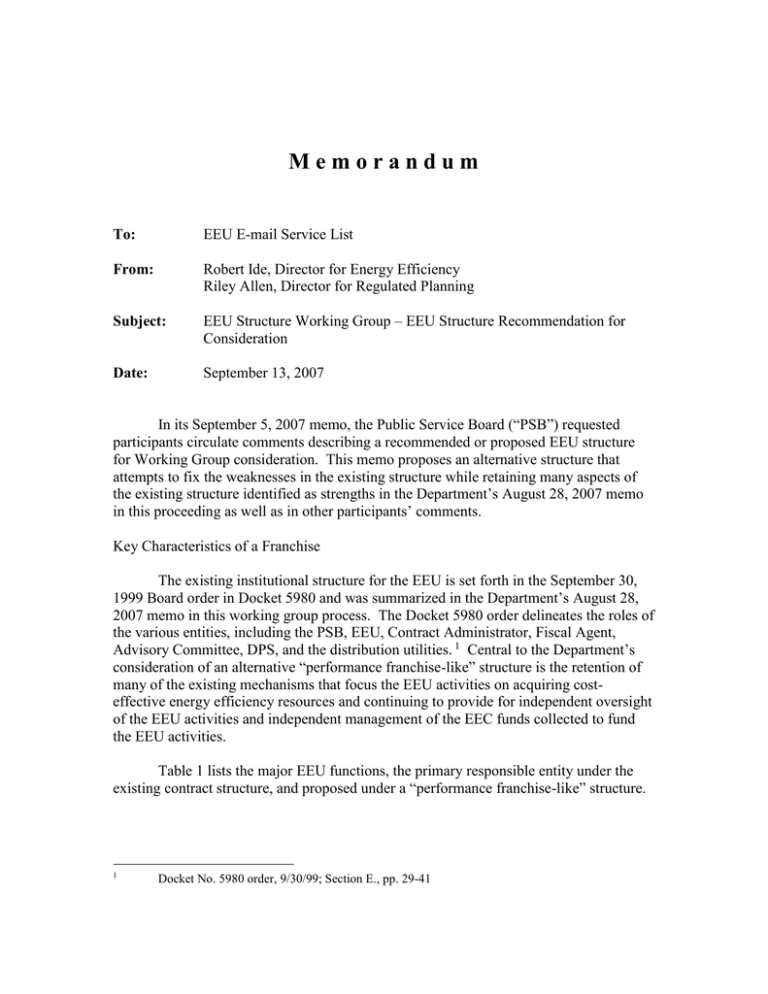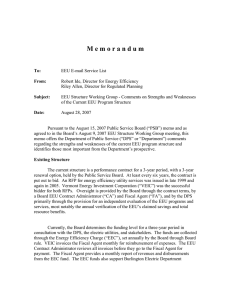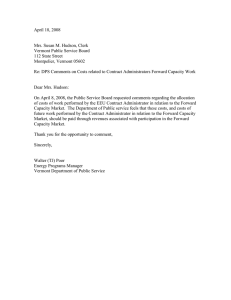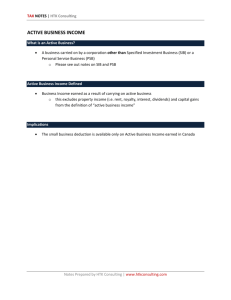M e m o r a n d u m
advertisement

Memorandum To: EEU E-mail Service List From: Robert Ide, Director for Energy Efficiency Riley Allen, Director for Regulated Planning Subject: EEU Structure Working Group – EEU Structure Recommendation for Consideration Date: September 13, 2007 In its September 5, 2007 memo, the Public Service Board (“PSB”) requested participants circulate comments describing a recommended or proposed EEU structure for Working Group consideration. This memo proposes an alternative structure that attempts to fix the weaknesses in the existing structure while retaining many aspects of the existing structure identified as strengths in the Department’s August 28, 2007 memo in this proceeding as well as in other participants’ comments. Key Characteristics of a Franchise The existing institutional structure for the EEU is set forth in the September 30, 1999 Board order in Docket 5980 and was summarized in the Department’s August 28, 2007 memo in this working group process. The Docket 5980 order delineates the roles of the various entities, including the PSB, EEU, Contract Administrator, Fiscal Agent, Advisory Committee, DPS, and the distribution utilities. 1 Central to the Department’s consideration of an alternative “performance franchise-like” structure is the retention of many of the existing mechanisms that focus the EEU activities on acquiring costeffective energy efficiency resources and continuing to provide for independent oversight of the EEU activities and independent management of the EEC funds collected to fund the EEU activities. Table 1 lists the major EEU functions, the primary responsible entity under the existing contract structure, and proposed under a “performance franchise-like” structure. 1 Docket No. 5980 order, 9/30/99; Section E., pp. 29-41 Table 1 Function Program Planning & Implementation Evaluation Contract Administration Budget setting Determination of Performance goals and objectives Determination of Minimum performance standards Setting Annual EEC Collecting EEC revenues EEC fund accounting Annual EEU/EEC fund audit Tri-annual Independent Audit of Energy & Capacity Savings Resource Planning Existing Contract Structure EEU ‘Franchise-like Structure” EEU DPS CA contract with PSB PSB PSB with DPS input DPS EEU w/DPS powers of investigation under Title 30 and PSB oversight PSB approved PSB approved PSB with DPS input PSB approved PSB Utilities FA contract with PSB PSB contract PSB contract PSB Utilities FA contract w/PSB PSB PSB Utilities/VELCO/DPS EEU/Utilities/VELCO/DPS The creation of, and powers granted to, a “performance-based -franchise” would have at least the following characteristics: 1. The Board would issue a certificate of public good (“CPG”) to an independent entity for an indefinite period of time, contingent on satisfactory performance, and with provisions for franchise revocation in the event of unsatisfactory performance and/or contingent on the continued need for the acquisition of cost effective energy efficiency resources. 2. Notice of revocation or franchise would trigger a formal competitive solicitation and award of the franchise to a new franchisee. 3. The Board would set total EEU annual budgets for an initial threeyear period, with an annual process to maintain a three-year forward budget that included the EEU, the DPS, the electric utilities, and other stakeholders. 4. Exemplary performance targets and incentives, satisfactory performance definitions, and other measurable performance benchmarks would be defined and detailed in the Board Orders pertaining to the CPG or elements of the regulatory regime not fully address in the CPF. The CPG or Board ordered terms of performance may look like the existing contract between VEIC and the Board, but without provision for direct Board oversight. 5. The CPG would include authorization for specified activities not directly related to the acquisition of cost-effective resources to the extent they further state energy policy goals. Examples include long-term planning, participation in the Vermont System Planning Committee (“VSPC”), and other appropriate activities. 6. Periodic reports on activities and progress towards performance goals would be required. 7. The Board would continue to set the EEC charge, direct the collection of funds through the electric utility franchises, and manage the funds through the fiscal agent mechanism. 8. Energy Efficiency Utility savings verification, and other independent EEU program evaluation activities would continue to be provided by the DPS. 9. The Board would continue jurisdiction on the use of forward capacity market (“FCM”) revenues received by the franchise holder. 10. The franchise holder would be responsible for short- and long-term planning and implementation of services and initiatives. 11. The franchise holder would be responsible for the prudence, used and usefulness of its expenditures directed toward activities undertaken under the auspices of its CPG. Its records would be subject to regulatory inspection under 30 V.S.A. 2006, as is now the case with Vermont regulated utilities. 12. The franchise holder would be considered a utility subject to the jurisdiction of the Board and the Department under Title 30 of the Vermont Statutes Annotated. 13. The franchise holder would be subject to the same rules that govern Vermont regulated utility legislative and lobbying efforts.




